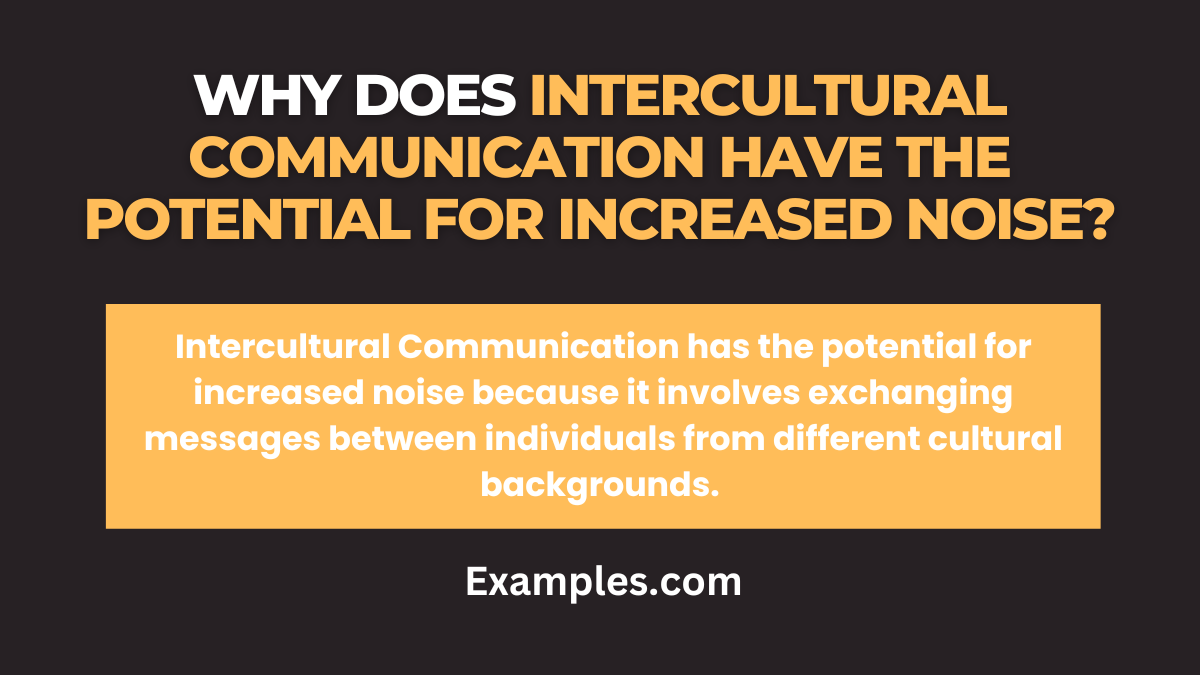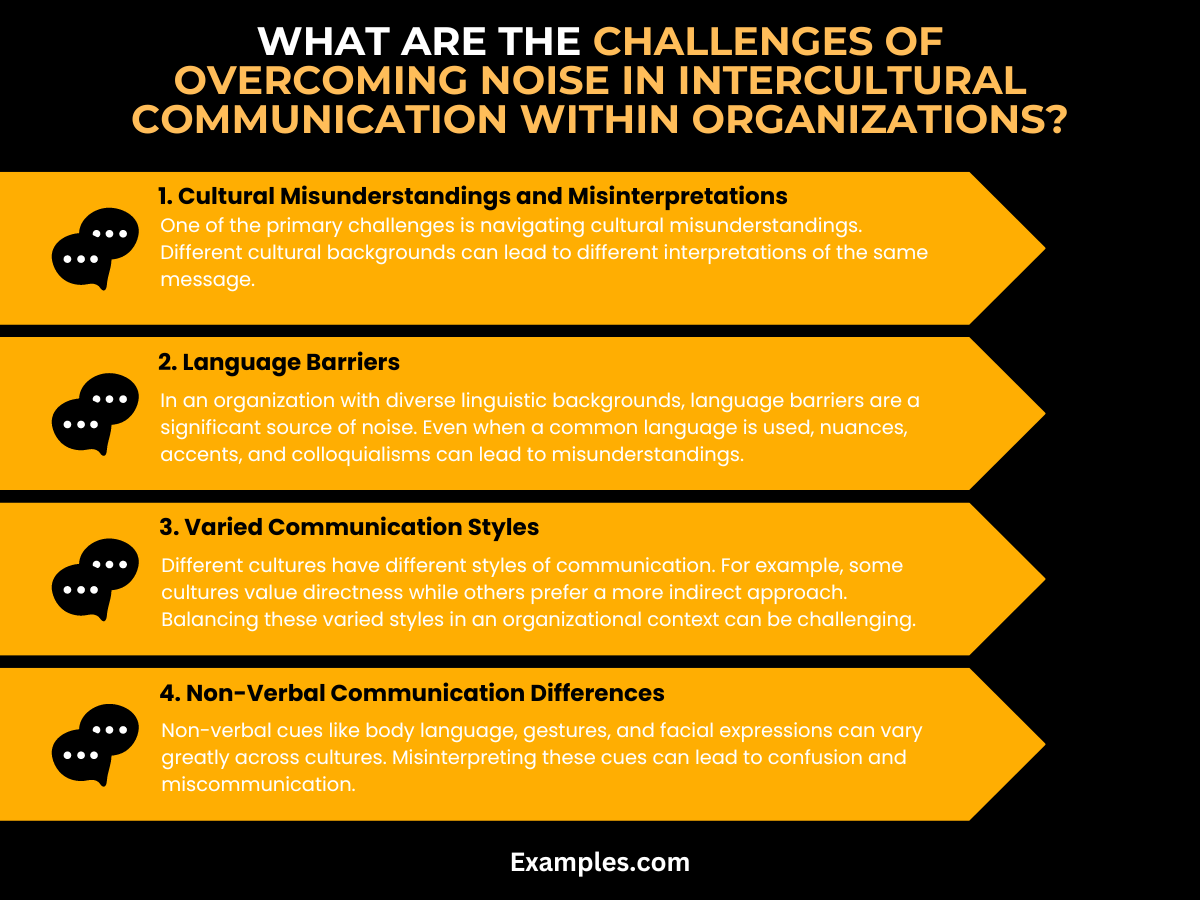Why does Intercultural Communication have the Potential for Increased Noise?
Delve into the intricate world of Intercultural Communication and understand why it is often susceptible to increased noise or misunderstandings. This comprehensive guide explores various factors contributing to communication challenges, backed by practical Intercultural Communication Examples. Whether in business, education, or personal interactions, this guide provides insights into the complexities of communicating across cultures, helping you navigate and reduce potential misunderstandings effectively.
Why does Intercultural Communication have the Potential for Increased Noise?

Intercultural Communication has the potential for increased noise because it involves exchanging messages between individuals from different cultural backgrounds. This can lead to misunderstandings and misinterpretations, as cultural differences often affect how messages are sent, received, and perceived. Factors like language barriers, differing non-verbal cues, and varied communication styles can all contribute to this ‘noise’, making it challenging to achieve clear and effective communication across cultures.
Why Some Potential Noise Affects Effective Communication Online?
In the context of Intercultural Communication, ‘noise’ refers to anything that hinders effective communication, especially online. Understanding the sources of this noise is crucial for improving interaction in our digitally connected world.
Technical Limitations
Online communication often faces technical issues such as poor internet connectivity, low-quality audio or video, and software glitches. These technical challenges can distort messages and lead to misunderstandings, particularly when communicating across different time zones and geographical locations.
Lack of Non-Verbal Cues
Online platforms significantly reduce the presence and effectiveness of non-verbal cues like body language and facial expressions. In intercultural contexts, where non-verbal communication can be as important as verbal, this lack of visual cues can lead to misinterpretations.
Cultural Misinterpretations
Differences in cultural backgrounds can lead to varied interpretations of messages. Humor, idioms, and colloquial language often do not translate well across cultures and can create confusion and miscommunication in online interactions.
Language Barriers
In a global online environment, language barriers are a common source of noise. Participants may not be native speakers of the language used, leading to difficulties in expression and comprehension.
Overload of Information
The digital platform often leads to an overload of information, which can be overwhelming. In intercultural settings, processing and responding to large volumes of information in a non-native language can be particularly challenging.
Echo Chambers and Confirmation Bias
Online communication often occurs within echo chambers where individuals are exposed predominantly to viewpoints similar to their own. This can foster confirmation bias and reduce exposure to diverse perspectives, limiting intercultural understanding.
Psychological Distance
The impersonal nature of online communication can create psychological distance between communicators. This distance can be exacerbated in intercultural settings, where establishing trust and rapport might already be challenging.
Assumptions and Stereotypes
The lack of personal interaction and reliance on text-based communication can lead to the formation or reinforcement of stereotypes. Misinterpretations due to cultural differences are often compounded by these preconceived notions.
How do Cultural Differences Contribute to Increased Noise in Intercultural Communication?
Cultural differences play a significant role in creating ‘noise’ or misunderstandings in Intercultural Communication. This noise is not just about language, but also encompasses a wide range of cultural nuances that can lead to confusion. Understanding how these differences contribute to communication challenges is essential for anyone involved in intercultural interactions.
Language and Translation Issues
- Vocabulary and Language Structure: Different languages have unique vocabularies and structures that can change the meaning of a message. Direct translations often fail to convey the intended nuances.
- Idioms and Expressions: Cultural-specific idioms and expressions may not have equivalent meanings in other languages, leading to confusion.
Non-Verbal Communication Variances
- Body Language and Gestures: Non-verbal cues like gestures, facial expressions, and posture vary significantly across cultures. For instance, a nod in one culture might mean agreement, while in another, it could signify a simple acknowledgment without agreement.
- Eye Contact and Personal Space: Norms regarding eye contact and personal space differ globally, potentially leading to discomfort or misinterpretation.
Differing Communication Styles
- Direct vs. Indirect Communication: Some cultures prefer direct communication, while others use indirect methods. This difference can result in misunderstandings, with one party perceiving the other as rude or evasive.
- High-Context vs. Low-Context Communication: High-context cultures rely heavily on implicit communication and context, whereas low-context cultures emphasize explicit verbal messages. Misunderstandings arise when these styles clash.
Diverse Cultural Contexts and Perceptions
- Different Values and Norms: Divergent cultural values and norms can lead to different interpretations of the same message. For example, what is considered assertive in one culture might be seen as aggressive in another.
- Cultural Stereotypes and Prejudices: Preconceived notions about other cultures can cloud judgment and lead to biased interpretations.
Varied Approaches to Conflict and Resolution
- Conflict Resolution Styles: Different cultures have unique ways of handling conflicts, from open confrontation to avoiding direct conflict. Misalignment in these styles can exacerbate misunderstandings.
- Perception of Time and Deadlines: Cultures perceive and value time differently, which can lead to misinterpretations regarding punctuality or meeting deadlines.
What are the Challenges of Overcoming Noise in Intercultural Communication within Organizations?
In the realm of Intercultural Communication, especially within organizations, overcoming noise presents unique challenges. These obstacles can significantly impact the efficiency and effectiveness of communication in a multicultural workplace setting. Understanding these challenges is the first step in developing strategies to address them.

Cultural Misunderstandings and Misinterpretations
One of the primary challenges is navigating cultural misunderstandings. Different cultural backgrounds can lead to different interpretations of the same message. What is considered polite or straightforward in one culture might be perceived as rude or ambiguous in another.
Language Barriers
In an organization with diverse linguistic backgrounds, language barriers are a significant source of noise. Even when a common language is used, nuances, accents, and colloquialisms can lead to misunderstandings.
Varied Communication Styles
Different cultures have different styles of communication. For example, some cultures value directness while others prefer a more indirect approach. Balancing these varied styles in an organizational context can be challenging.
Non-Verbal Communication Differences
Non-verbal cues like body language, gestures, and facial expressions can vary greatly across cultures. Misinterpreting these cues can lead to confusion and miscommunication.
Stereotypes and Prejudices
Preconceived notions and stereotypes about certain cultures can create biases in communication. These biases can affect how messages are sent, received, and interpreted within the organization.
Resistance to Change
In some organizational cultures, there can be resistance to adopting new communication strategies that accommodate cultural diversity. This resistance can stem from a lack of awareness or unwillingness to adapt.
Overcoming Technological Challenges
In today’s digital age, much intercultural communication occurs via electronic means. Technical issues like poor connectivity or unfamiliarity with digital tools can amplify communication challenges.
Ensuring Inclusivity
Creating an inclusive communication environment that caters to all cultural backgrounds is a complex task. It requires ongoing effort to ensure that all voices are heard and respected.
Training and Development
Providing effective training in intercultural communication is a challenge. It requires resources, time, and commitment from the organization to develop and implement effective training programs.
Balancing Global and Local Needs
In multinational organizations, balancing the global corporate culture with local cultural nuances can be challenging. Ensuring that communication strategies are effective across all levels of the organization is a complex task.



